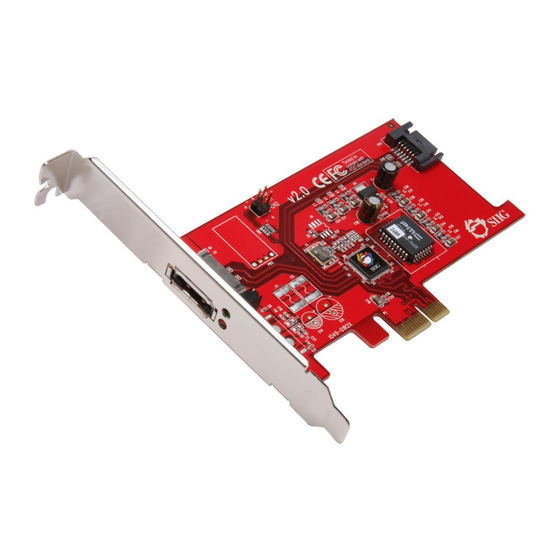
Table of Contents
Advertisement
Quick Links
SATA II PCIe
Quick Installation Guide
Introducing the SATA II PCIe i/e
The SATA II PCIe i/e is an ultra high-speed dual channel
Serial ATA Generation 2 controller for use in PCI Express-
enabled system.
Features and Benefits
•
Compliant with PCI Express Base Specification 1.0a
•
Compliant with Serial 1.0a specification with support
for full complement of SATA II optional features
•
PCI Express 1-lane (x1) SATA II adapter works with
PCI Express slots with different lane width
•
Installs in any available PCI Express slot and support
data transfer rates up to 3.0Gbps (300MBps)
•
Spare enchanced low profile bracket is included to
work in low profile chassis
•
Supports Native Command Queuing (NCQ), Non-
zero offsets NCQ, and Out-of-order date delivery
NCQ
•
Independent command fetch, scatter/gather, and
command execution
•
Supports hard disk hot-plugging
System Requirements
PCI Express-enabled system with an available PCI
•
Express slot
Windows 2000/XP/Server 2003
•
04-0395A
i/e
1
Advertisement
Table of Contents

Subscribe to Our Youtube Channel
Summary of Contents for SIIG SC-SAE212-S2
-
Page 1: Quick Installation Guide
SATA II PCIe Quick Installation Guide Introducing the SATA II PCIe i/e The SATA II PCIe i/e is an ultra high-speed dual channel Serial ATA Generation 2 controller for use in PCI Express- enabled system. Features and Benefits • Compliant with PCI Express Base Specification 1.0a •... -
Page 2: Hardware Installation
Package Contents SATA II PCIe i/e adapter and spare enchanced low • profile bracket SATA data cable and SATA 15-pin power cable • Driver CD and user's manual • Board Layout External Connector HDD Activity Figure 1. SATA II PCIe i/e Board Layout Hardware Installation General instructions for installing the card are provided below, since the design of computer cases and... - Page 3 Remove your computer’s cover. Remove the slot bracket from an available PCIe slot. To install the card, carefully align the card's bus connector with the selected PCIe slot on the motherboard. Push the board down firmly, but gently, until it is well seated. Replace the slot bracket's holding screw to secure the card.
-
Page 4: Driver Installation
Attach the other end of the Serial ATA cable to the internal Serial ATA port. Replace the computer cover and reconnect the power cord. External Serial ATA port: External Serial ATA devices should come with their own accessories. In most cases, you just need to power up the external device and connect it to the external port. - Page 5 Press Enter to continue and follow on-screen instructions to complete the installation. Existing Windows 2000 Installation Install the board and boot up Windows 2000. At the Found New Hardware Wizard, click Next. Select Search for a suitable driver for my device (recommended) and click Next.
-
Page 6: Bios Configuration
Existing Windows XP/Server 2003 Installation Install the board and boot up Windows XP/Server 2003. At the Found New Hardware Wizard, Insert the driver CD, select Install the software automatically (Recommended), then click Next. Click Finish. Restart Windows to complete the driver installation. To Verify Windows 2000/XP/2003 Installation Right click My Computer and click Manage. -
Page 7: Technical Support And Warranty
A lifetime manufacturer warranty supplied with this product is offered by SIIG, Inc. Please see SIIG website for more warranty details. If you should happen to encounter any problems with this product, please follow the procedures below. - Page 8 Fremont, CA 94538-3152 SATA II PCIe i/e is a trademark of SIIG, Inc. SIIG and SIIG logo are registered trademarks of SIIG, Inc. Microsoft and Windows are registered trademarks of Microsoft Corporation. Other names used in publication are for identification only and may be trademarks of their respective companies.












Need help?
Do you have a question about the SC-SAE212-S2 and is the answer not in the manual?
Questions and answers